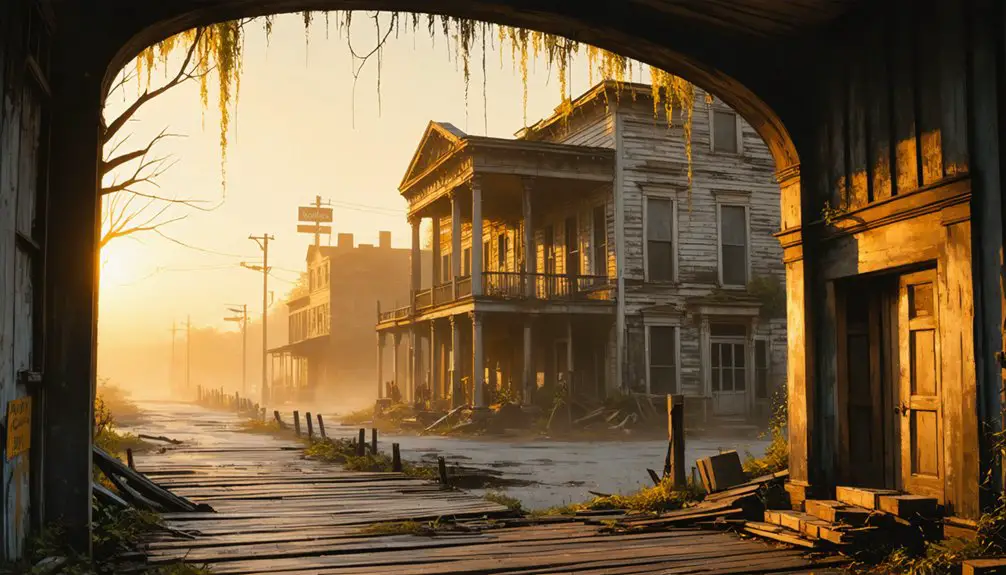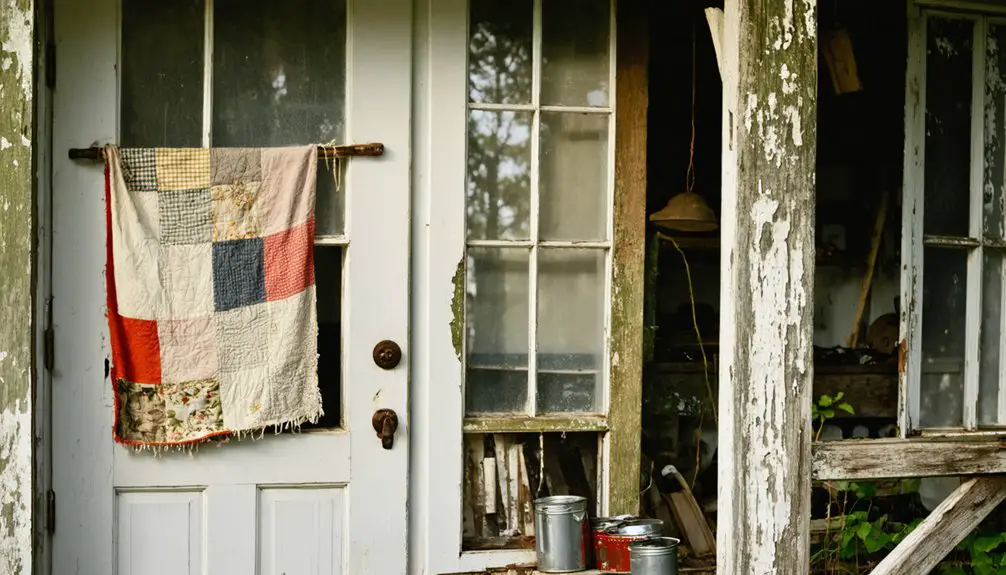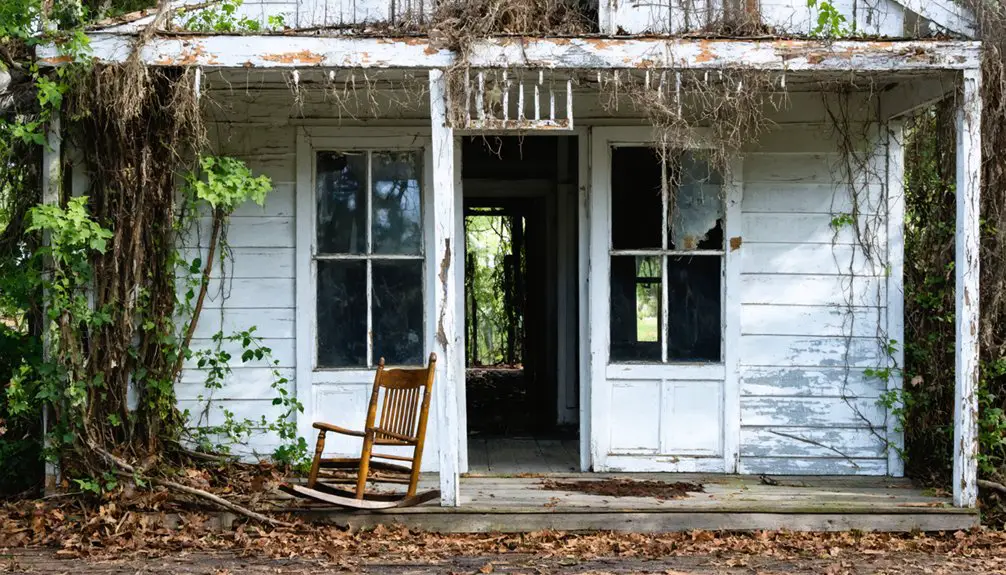You’ll find White City, Florida’s fascinating origins in an 1893 Danish settlement inspired by Chicago’s World’s Fair. Led by Louis Pio, 500 Danish settlers established a vibrant community along the St. Lucie River, complete with the White City Mercantile and Improvement Club. Though a devastating land scheme by Colonel Myers and the Great Freeze of 1894-1895 challenged early settlers, their resilience shaped this historic community. The surviving architecture and cultural heritage tell an even more compelling story.
Key Takeaways
- The 1893 Danish settlement in White City suffered severe economic decline after Colonel Myers’ land scheme defrauded settlers of their investments.
- White City’s transformation into a ghost town accelerated after the Great Freeze of 1894-1895 devastated agricultural prospects.
- The original vision of a thriving Scandinavian colony collapsed following Louis Pio’s death and subsequent financial hardships.
- Many settlers abandoned White City after bankruptcy, leaving behind their properties and the once-bustling Danish community of 500 residents.
- Despite the exodus, some historic structures like the Captain Hammond House and White City Marketplace remain as testament to settlement’s past.
The Danish Dream in the Sunshine State
Dreams of a new Scandinavian community drew Danish settlers from the Midwest to Florida in 1893, inspired by the grandeur of Chicago’s World’s Fair “Great White City” exposition.
Under the leadership of Louis Pio, a Danish promoter from Chicago, you’d find these pioneers purchasing land from railroad magnate Henry Flagler, keen to establish their cultural foothold in the Sunshine State. The White City Mercantile became one of the earliest establishments along Midway Road, serving as a vital hub for the growing community.
Led by Chicago promoter Louis Pio, Danish settlers found opportunity in Florida through Flagler’s land sales, eager to plant Scandinavian roots.
The settlers’ commitment to Danish identity and cultural preservation took shape through the White City Improvement Club, founded in 1894.
You’ll recognize their dedication in how they maintained exclusive Scandinavian membership, organized monthly dances, and kept Danish language alive in daily life.
The town’s name and its main thoroughfare, Midway Road, proudly reflected their World’s Fair inspiration, creating Florida’s largest Danish settlement where traditional customs and architecture flourished. The promising start turned tragic when Colonel Myers absconded with the townspeople’s savings, devastating the community’s economic foundation.
From Chicago’s White City to Florida’s Frontier
While Chicago’s White City drew inspiration from the grand White City of the 1893 World’s Columbian Exposition, you’ll find its influence reached far beyond Illinois to shape dreamers’ visions in Florida.
With a million lights illuminating the night sky and visible from 15 miles away, Chicago’s beloved amusement park stood as a shining beacon of progress that would inspire developments nationwide.
Spanning fourteen acres with elegant gardens and strolling paths, the park created an immersive escape for urban visitors.
You can trace how the elegant Beaux-Arts architecture and entertainment offerings of Chicago’s amusement park sparked similar aspirations among Danish settlers in the Sunshine State.
Whether in Chicago’s bustling urban landscape or Florida’s frontier territory, the White City concept represented a powerful symbol of progress and possibility for early 20th-century communities.
World’s Fair Connection
As the grand neoclassical buildings of Chicago’s 1893 World’s Columbian Exposition dazzled millions with their pristine white facades, they sparked a legacy that would reach far beyond Illinois to inspire a small frontier community in Florida.
You’ll find this cultural exchange embodied in White City, Florida, where early settlers paid homage to the fair’s grandeur by naming their town after the gleaming exhibition. A Danish settlement colony formed the foundation of the early community.
The architectural influence of Daniel Burnham’s neoclassical vision echoed in the community’s aspirations, while Midway Road stands as a symbol to the fair’s famous entertainment district. Today, the area maintains its small-town atmosphere while preserving its unique historical connection.
The connection runs deeper than mere naming – it represents the pioneering spirit of both ventures, from the fair’s groundbreaking AC power demonstrations to the determination of Florida’s frontier settlers to build something remarkable.
Danish Dreams Down South
In 1893, a vibrant Danish community took root in Florida’s frontier when 500 settlers, primarily from Chicago’s bustling Midwest, followed promoter Louis Pio’s vision of establishing a new life in the South. They purchased land from railroad magnate Henry Flagler, naming their settlement White City after the famous Chicago World’s Fair.
Danish traditions flourished through the White City Improvement Club, where settlers preserved their heritage with monthly dances, Sunday coffee klatches, and the everyday use of their native language. The Florida Historical Society later documented these cultural practices through scholarly publications and historical records.
Their immigrant resilience was soon tested when land agent Myers disappeared with their funds and the devastating freeze of 1894-1895 destroyed their crops. Despite these setbacks, the community’s strong cultural bonds and support from Flagler’s railroad helped them persevere, though many eventually abandoned their Florida dreams.
Louis Pio’s Vision and Settlement Planning
Through his role at the 1893 Chicago World’s Fair‘s Florida Exhibit, Danish promoter Louis Pio launched an ambitious vision for White City – a Scandinavian immigrant colony along Florida’s east coast.
He strategically selected land along the St. Lucie River, partnering with railroad magnate Henry Flagler to establish a settlement that would preserve Danish heritage while offering new opportunities.
You’ll find Pio’s influence in the town’s design, with Midway Road named after the World’s Fair’s main avenue.
He organized promotional campaigns targeting Danish and Norwegian immigrants, offering financial incentives like $5 bounties for families. Through publications like The Danish Pioneer and special excursion trains, he attracted settlers from Chicago, Nebraska, and Scandinavia.
Sadly, Pio’s death shortly after arriving in White City derailed the community’s original vision.
The Rise of Midway Road and Early Development
Midway Road emerged as White City‘s central artery in 1893, drawing its name from the Chicago World’s Fair’s grand Midway Plaisance entertainment boulevard.
You’ll find this road’s legacy deeply intertwined with the town’s initial growth, as Danish settlers under Louis Pio’s leadership established their community along its path. By 1898, the growing settlement had been organized into 26 city blocks.
Despite early setbacks, including a devastating financial scandal and the harsh winter freeze of 1894-1895, Midway commerce proved resilient. The remaining settlers earned their land deeds through improving the surrounding property.
Through financial turmoil and brutal weather, Midway’s merchants demonstrated unwavering determination to keep commerce flowing along this vital artery.
The road became essential for agricultural transport, connecting local farmers to Flagler’s railroad network.
Community resilience showed through the settlers who stayed, clearing land and improving infrastructure around the thoroughfare.
Colonel Myers and the Great Financial Scandal

In the winter of 1894, you’d have witnessed Colonel Myers, a California con man, executing an elaborate scheme that defrauded White City’s early settlers of their life savings through false land sale promises.
Working alongside Louis Pio, Myers collected substantial down payments from trusting community members while failing to deliver the promised property deeds. Like many organized crime figures emerging in Florida during this era, Myers operated with impunity until his schemes were exposed.
Myers’ sudden disappearance with the town’s funds left the fledgling community in financial ruins, though the settlers would eventually demonstrate remarkable resilience by reorganizing and stabilizing within two years.
Bank Collapse Ruins Community
When Colonel Myers fled White City with the settlers’ funds shortly after their arrival, he devastated the fledgling community’s financial foundation and crushed their dreams of prosperity. The impact rippled through every aspect of settlers’ lives, leaving them struggling for basic survival in their new home.
The collapse brought severe consequences:
- Settlers faced destitution and relied heavily on charitable assistance.
- Agricultural development stalled, delaying essential farm establishment.
- Community morale plummeted, causing some resourceful settlers to abandon the town.
You’ll find that community resilience emerged despite these challenges. While the bank’s failure left long-lasting damage, settlers adapted by focusing on pineapple farming until conditions improved.
Though financial recovery took years, new community agents arrived in 1897, bringing hope and improved governance to the struggling settlement.
Myers’ Deceptive Land Scheme
Shortly after White City’s founding in 1893, Colonel Myers orchestrated one of Florida’s most notorious land schemes that would devastate the fledgling settlement.
Through calculated Myers’ manipulation, he positioned himself as a trusted community visionary, collecting residents’ down payments for land parcels and gathering their savings for a promised bank venture.
You’d have witnessed settlers placing their life savings and dreams in his hands, only to face crushing trust betrayal when Myers vanished with their money.
His deception left the community reeling, forcing many original settlers to abandon their hopes of establishing roots in White City.
While the scandal delayed the town’s growth, it sparked the creation of the White City Improvement Club in 1904, demonstrating the settlers’ resilience in rebuilding their community from the ashes of fraud.
Settlers Lose Life Savings
The devastating financial collapse orchestrated by Colonel Myers left White City’s middle-class settlers facing unprecedented hardship and ruin. As local financial institutions crumbled, entire families watched their life savings vanish, shattering their dreams of prosperity in Florida’s promising frontier. The widespread financial losses destroyed community trust and triggered a mass exodus from White City.
- Bankruptcy filings surged as settlers couldn’t recover their investments, forcing many to abandon their homes.
- Property values plummeted while local businesses shuttered, creating a downward spiral of economic decline.
- Families endured severe emotional distress, with many experiencing displacement and the dissolution of their social networks.
The scandal’s aftermath transformed White City into a shell of its former self, serving as a stark reminder of how quickly dreams can unravel through deceptive schemes.
Natural Disasters Strike: The Great Freeze and Malaria

During Florida’s formative years, two devastating natural disasters struck White City and surrounding communities: the Great Freeze of 1894-1895 and widespread malaria outbreaks.
You’d have felt the bone-chilling impact when temperatures plummeted to 18°F in Orlando, destroying citrus crops and devastating the region’s economy. Many of your neighbors would’ve lost their entire groves, their life savings wiped out in just two brutal freezes – one in December 1894 and another in February 1895.
Meanwhile, malaria’s relentless grip on the community made survival even more challenging. The mosquito-borne illness delayed White City’s development, forcing settlers to battle both economic hardship and life-threatening disease.
These twin disasters reshaped settlement patterns across Florida, as many residents abandoned their homes in search of more favorable conditions elsewhere.
Agricultural Ventures and Railroad Connections
While Danish immigrants laid White City’s agricultural foundation in the 1890s under Louis Pio’s leadership, their early farming ventures faced significant challenges.
Agricultural innovation emerged through necessity as settlers adapted to Florida’s unique growing conditions.
- Pineapple cultivation dominated initial farming efforts until World War I, when citrus farming became the area’s agricultural mainstay.
- Railroad expansion played an essential role, with the Florida East Coast Railroad building an “Immigrant House” and providing necessary transportation for crops.
- The Nelson family exemplified successful adaptation, starting citrus operations in the 1930s and pioneering gift fruit shipping along Old Dixie Highway.
You’ll find that White City’s agricultural success stemmed from the important partnership between determined farmers and railroad infrastructure, creating lasting economic opportunities despite early setbacks.
The Immigrant House and Community Support

You’ll find the Railroad-built Immigrant House stood as a critical shelter for newly arriving settlers, providing temporary lodging until they could establish permanent homes.
The facility served as more than just housing – it became a hub for community support and aid distribution during the settlement’s early crises, including crop failures and disease outbreaks.
Within its walls, Danish settlers formed strong communal networks that helped the fledgling community survive its most challenging years, especially after their financial manager’s betrayal left many destitute.
Railroad Shelter Program
As settlers faced mounting challenges in White City, Florida, the railroad’s Immigrant House emerged as a vital lifeline for the community. The railroad impact became evident as this shelter provided temporary housing for newcomers struggling to establish themselves, especially after a manager’s theft of community funds left many destitute.
The shelter’s significance extended beyond basic housing, demonstrating the railroad’s commitment to the settlement’s survival.
You’ll find that the program offered:
- A safe haven for settlers until they could build their own homes
- Important support during financial hardships and natural disasters
- A gathering place that strengthened community bonds during difficult times
Flagler’s generosity through the Immigrant House program proved indispensable, helping White City’s residents weather severe challenges including the Great Freeze of 1894 and malaria outbreaks of 1896.
Danish Communal Aid Network
When Danish immigrants settled in White City during the late 1800s, they established a robust communal aid network centered around the Danish Brotherhood in America.
You’ll find that Danish organizations like the Brotherhood played a vital role in helping newcomers find employment, housing, and economic opportunities through their fraternal bonds.
The immigrant networks extended beyond basic support, encompassing cultural preservation and community development.
Through formal structures and leadership roles, members like Mark Hansen helped build essential infrastructure, including schools and general stores.
If you were a Danish immigrant arriving in White City, you’d have found a well-organized support system that eased your adjustment into American life while maintaining your cultural heritage through traditional celebrations and customs.
Surviving Settlers and Their Legacy
Despite facing devastating setbacks like Louis Pio’s death and financial fraud by Mr. Myers, White City’s surviving settlers demonstrated remarkable resilience by adapting and rebuilding their community.
You’ll find their settler resilience reflected in how they shifted from pineapple to citrus farming and worked through the railroad’s credit system to maintain their land claims.
The community heritage of these determined settlers lives on through:
- The historic White City Marketplace, which remains a symbol of early commercial activity
- Original street layouts inspired by Chicago’s World Fair, including the iconic “Midway”
- Preserved early 1900s homes and landmarks maintained by settlers’ descendants
Through the Immigrant House’s support and Nels Hansen’s White City Improvement Club, these pioneers established lasting foundations that transformed initial hardships into a viable community.
Historical Buildings and Present-Day Remnants
The architectural legacy of White City’s early settlers remains visible through several historic structures that dot the landscape today.
You’ll find the 1902 Captain Hammond House showcasing Danish architecture with its distinctive blend of formal public rooms and private spaces, while its southern verandah adapts to the local climate.
The historic White City Marketplace stands as a reflection of community resilience, once serving as a crucial hub where steamboats delivered supplies along the St. Lucie River.
A testament to pioneering spirit, White City Marketplace anchored river commerce as steamboats brought vital supplies to this growing settlement.
Along Midway Road, named after the 1893 Chicago World’s Fair, you’ll discover the town’s thoughtful layout influenced by the City Beautiful Movement.
Frame vernacular homes still line Citrus Avenue, their modest designs reflecting the practical needs of early Danish settlers who shaped this unique community.
Frequently Asked Questions
What Happened to Colonel Myers After He Fled With Settlers’ Money?
You won’t find definitive records of Myers’ fate after he vanished with settlers’ money. Despite their grievances, he likely changed his identity or left Florida, successfully evading prosecution for his crimes.
Did Any of the Original Danish Families Maintain Connections With Denmark?
While Danish heritage flowed through their veins, you’ll find little concrete evidence of original families maintaining formal ties with Denmark, though informal family connections likely persisted through cultural gatherings and ethnic publications.
What Was the Population of White City at Its Peak?
You won’t find precise peak population figures in historical records, but today’s growth shows around 5,938 residents – far higher than when it was considered a ghost town years ago.
Were There Any Notable Conflicts Between Danish Settlers and Local Residents?
Detailed documents don’t show direct disputes between Danish settlers and local residents. You’ll find they faced financial fraud and farming failures, but they weren’t battling neighbors – just preserving their peaceful cultural practices.
Did White City Have Its Own School System in Early Years?
You won’t find evidence of an independent school system in those early years. Local school history suggests residents likely relied on county-level community education rather than dedicated White City facilities.
References
- https://rovingraconteurs.com/2021/05/16/a-day-in-stuart-florida-with-a-quick-look-at-white-city/
- https://www.ghosttowns.com/states/fl/whitecity.html
- https://npgallery.nps.gov/GetAsset/3b8d95b5-e853-46d7-9199-9dd43e4c1780
- https://stluciehistoricalsociety.net/19th-early-20th-century-communities/
- https://www.youtube.com/watch?v=hB-fU5HVMUo
- http://dpanther.fiu.edu/sobek/content/FI/18/05/09/00/00034/71375_74_04.pdf
- https://www.jstor.org/stable/30138934
- http://chicagology.com/skyscrapers/skyscrapers069/
- https://en.wikipedia.org/wiki/White_City_(Chicago)
- https://en.wikipedia.org/wiki/White_City_(amusement_parks)



